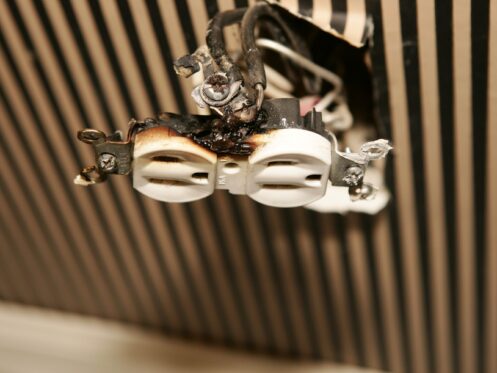You expect your lights to turn on, your outlets to work, and your appliances to run without a second thought. However, seemingly small electrical problems can escalate into significant issues hidden within your walls. From flickering bulbs to overloaded circuits, a lot can go wrong if things aren’t installed or maintained correctly. If you’re ready to keep your home safe and your power reliable, this guide will show you what to watch for and what to avoid.
1. Overloaded Circuits: Why They’re Dangerous
A common electrical problem in homes is an overloaded circuit. This happens when you plug in too many devices to one outlet or circuit, making it carry more power than it’s meant to handle. When that happens, the circuit can overheat, which could lead to a fire. For example, running several space heaters and electronics on the same circuit can quickly overload it.
To avoid this problem, know how much power your appliances need and how much your system can handle. If you frequently use multiple devices in one area, consider adding extra circuits or upgrading your electrical panel. Skip daisy-chaining your power strips and unplug appliances when you’re not using them.
If you are not sure about your circuit load, call an electrician. They’ve got the tools and know-how to check your system and make sure everything’s safe and running smoothly.
2. Flickering Lights: What’s Behind the Glitch?
Flickering lights are another frustrating electrical issue that could mean you have one of several underlying problems. While it’s easy to brush off a flickering bulb as a minor inconvenience, this issue can signal a much bigger problem. For instance, a loose or damaged light bulb might cause the flickering. If the flickering involves more than one bulb, the cause could be more serious
More serious causes might be an overloaded circuit, which prevents enough voltage from reaching your lights, or a problem with the electrical panel. If just one bulb is flickering, try replacing it or tightening the connection. But if the flickering affects multiple lights, it’s time to call an electrician.
3. Electrical Noise: Buzzing and Humming
If you hear buzzing or humming from your outlets or light switches, it might seem harmless; however, that electrical noise could be a warning sign that something’s off. Usually, it’s caused by loose connections or faulty wiring. In some cases, the sound might also be due to an overloaded circuit, where more electricity is flowing through your wires than they can handle.
The buzzing noise may come from a light fixture or an electrical outlet and indicate that the wire connections aren’t secure. Over time, these loose connections can lead to overheating and even cause fires. If the noise continues or worsens, it’s time to get an electrician to check out your system.
4. Outdated Wiring
Old wiring is a major issue in many homes, especially those built before the 1980s. Over time, the insulation around the wires can break down, leaving them exposed and at risk of damage. Frayed or exposed wires can easily cause fires. Plus, older wiring might not be able to handle the power needed for today’s appliances, which can lead to overheating and overloading.
If you live in an older home, it’s important to check your electrical system regularly. Watch out for signs of damage, like exposed or frayed wires, scorch marks around outlets, or a constant burning smell. If your home still has aluminum wiring (less safe than copper), you may need to replace your wiring entirely. It’s a bigger investment, but it can keep your home safe from electrical fires. Modern copper wiring is much safer and designed to handle the increased electrical demands of today’s appliances and technology.
5. Electrical Shocks: Preventing Them
Electrical shocks can be more than just a nuisance. They can result in severe injury or even be fatal if you come into contact with faulty wiring, improperly grounded outlets, or damaged appliances.
To avoid electrical shocks, ensure all outlets in your home are properly grounded. You can test this with an outlet tester, a cheap tool available at most hardware stores. It’s also important to avoid using electrical appliances with frayed cords and never pull on a cord to unplug an appliance. If you receive a shock from an outlet or appliance, stop using it immediately and get it checked out by an electrician.
6. Power Surges: What They Are and How to Protect Your Devices
Power surges happen when voltage spikes (often caused by lightning), power outages, or even a faulty appliance occur. These spikes can fry your electronics, damage devices, and throw off your power supply, often without any warning. They can wreak havoc on everything from your computer to your refrigerator.
The best way to shield your home is with surge protectors. Unlike regular power strips, surge protectors absorb those dangerous spikes and keep them from reaching your valuable electronics. While power strips provide additional outlets, surge protectors have built-in protection against power surges. Ensure you use a quality surge protector, not just a cheap power strip, especially for valuable electronics like computers, televisions, and refrigerators. Additionally, if your area is prone to storms, you might want to install a whole-home surge protector. Protecting your electrical devices from sudden voltage spikes provides significant peace of mind.
7. Dead Outlets: Why They Stop Working and What to Do
When an outlet stops working, it could be caused by a number of issues, from a blown fuse to a wiring problem. It’s especially problematic if the outlet is one that you frequently use, like for your refrigerator or microwave. A dead outlet may also be caused by a faulty circuit breaker or a disconnected wire somewhere along the line.
If you have a dead outlet, don’t attempt to fix it yourself unless you have experience working with electrical systems. The issue could be simple, like a loose wire, but it could also be something more complicated, like a grounding issue. To determine the cause, it’s best to call an electrician who can safely inspect and diagnose the problem.
8. Fuse Boxes Not Up to Code
Many homes still have fuse boxes instead of modern circuit breakers. While fuse boxes were adequate for the electrical demands of earlier eras, they often lack the capacity and safety features required for today’s modern appliances. Fuse boxes are less reliable, harder to troubleshoot, and can be dangerous if they malfunction. The main problem with a fuse box is that you need to replace a blown fuse, which can be inconvenient and a safety concern. Additionally, fuse boxes typically don’t have the same capacity as modern circuit breaker panels, which means they can’t safely handle the electrical demands of modern appliances.
Switching from a fuse box to a circuit breaker panel can improve the overall safety of your home electrical system. Circuit breakers are more efficient, easier to reset, and can better handle the increased load from modern appliances like air conditioners, electric dryers, and kitchen gadgets. If your home still uses a fuse box, it’s worth considering an upgrade to avoid potential risks.
Check the Electrical Health of Your Home
Electrical problems won’t disappear on their own. Ignoring the warning signs or delaying inspections can make your home vulnerable to costly damage and serious safety threats. Take control by learning what to look for and acting decisively. If your Beckley home requires a professional checkup, schedule an inspection with our electrical services experts at Childers Air Plumbing & Electric today. For complete home well-being, we also offer a variety of other essential services, including indoor air quality solutions, trenchless sewer repairs, and generator installations.
Give us a call at Childers Air Plumbing & Electric for all your home service needs.

